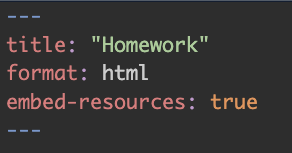| # | Homework Due | Peer Review Due |
|---|---|---|
| 1 | 7 October | 12 October |
| 2 | 14 October | 19 October |
| 3 | 21 October | 26 October |
| 4 | 28 October | 2 November |
| 5 | 11 November1 | 16 November |
| 6 | 18 November2 | 23 November |
| 7 | 25 November | 30 November |
| 8 | 2 December | 7 December |
| 9 | 9 December | 14 December |
| 1 You will have two weeks to complete Homework 5 | ||
| 2 We will cover content for Homework 6 two weeks prior to its due date | ||
Overview
This page contains general instructions for assignments/peer reviews. For homework-specific instructions and templates go to the specific assignment listed on the left.
A Note About Rendering Your HTML documents
You need to include embed-resources: true in your YAML header in order for your HTML documents to include any plot output when you upload them to Canvas. It should look something like the following:

You can read more about this option here but basically, whenever you render a .qmd file to HTML, all output created goes into a separate, associated folder, which is referenced when displaying the page in your web browser. However, when you upload the HTML file separately from that folder (e.g. to Canvas or through email), it doesn’t have the specific output images to reference, so they won’t appear. When you specify in your YAML header that you want to embed resources, you’re explicitly adding the output created by your code to the HTML file so that a separate output folder is longer created and you can send your HTML file with all its output as one entity.
Assignment Due Dates
All assignments should be created using Quarto and uploaded to Canvas as both html and qmd files. Your document should be pleasant for a peer to look at and follow all instructions. Use sections for organization, label figures/tables, and use code chunks.
Rubric Students Use to Grade Assignments:
| Evaluation | Points |
|---|---|
| Didn’t turn anything in. | 0 |
| Turned in but low effort, ignoring many directions. |
1 |
| Decent effort, followed directions with some minor issues. |
2 |
| Nailed it! | 3 |
Peer Review:
You are required to both grade and provide feedback on a peer’s homework each week. Reading/evaluating the work of others is useful and important! Good programmers realize that most problems have been solved by others; the trick is figuring out how to apply existing code to new problems. You will develop this skill by reading others’ code, evaluating their approach to problems, providing suggestions, and pointing out when you learned something new. Poor peer reviews are impolite or unprofessional, are generic (i.e., could be applied to anyone’s homework), or fail to provide useful suggestions. Good peer reviews give constructive, polite, and insightful comments, are specific and concise, use the grading rubric above, and point out what you learned from their code.
Peer reviews are randomly assigned when the due date/time is reached. Therefore, if you don’t submit your homework on time, you will not be given a peer’s homework to review and vice versa. That said, life is messy and complicated and we all miss deadlines for a variety of reasons. Therefore, you can request that I review and provide feedback on a late assignment (message me on Slack) but you won’t be able to earn peer-review credit for that particular homework.
Rubric Instructor Uses to Grade Peer Review:
| Evaluation | Points |
|---|---|
| Didn’t follow all peer-review instructions. | 0 |
| Peer review is at least several sentences long, mentions any and all key issues from the assignment, and points out at least one positive thing in your peer’s work (and hopefully more!). | 1 |
When to Contact the Instructor:
A number of situations may warrant contacting the instructor:
If you believe you have received an unfair peer review, you can request for evaluation by the instructor. The assignment will be regraded, which may result in a higher, same, or lower grade.
If you wish for more feedback on a particular part of the homework, you can ask the instructor for additional explanation during office hours or over Slack.
If you receive no feedback, I will provide peer review by request.